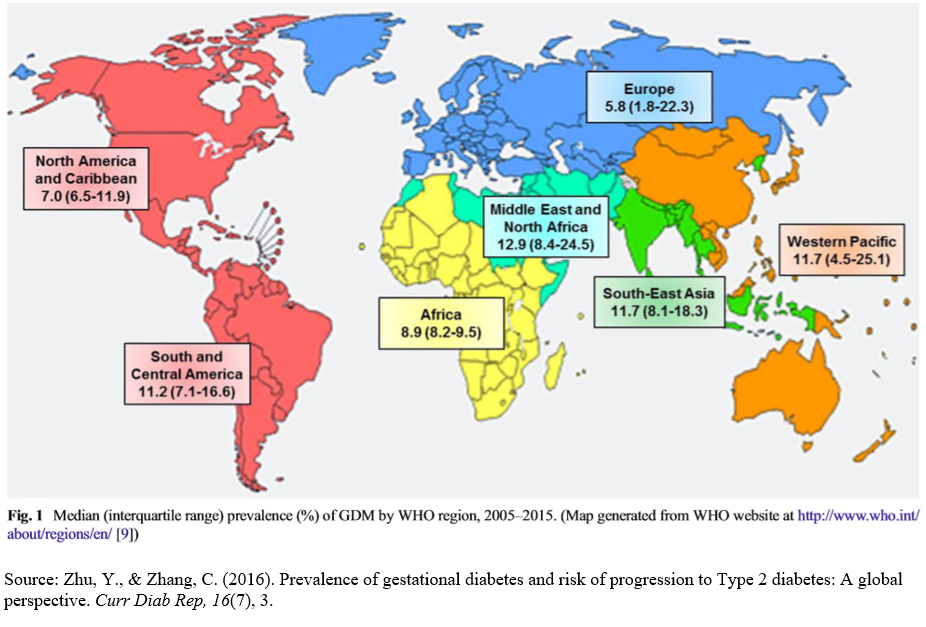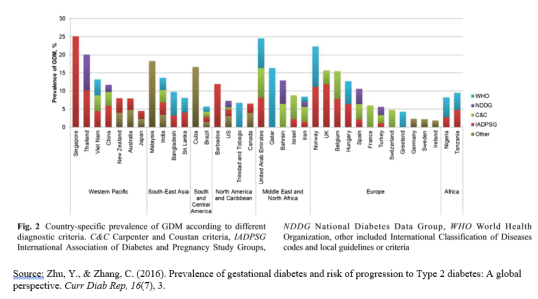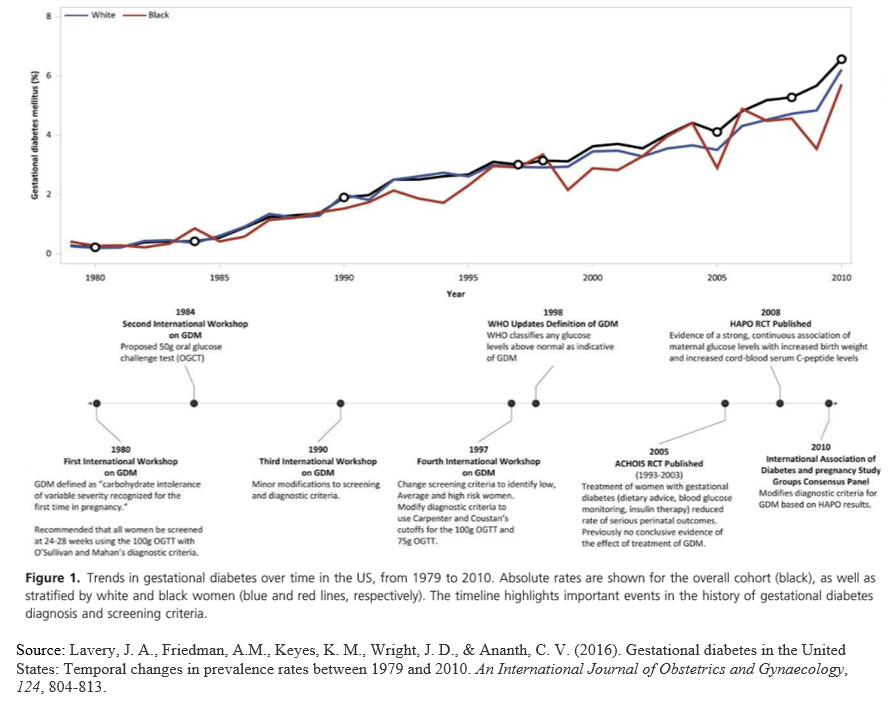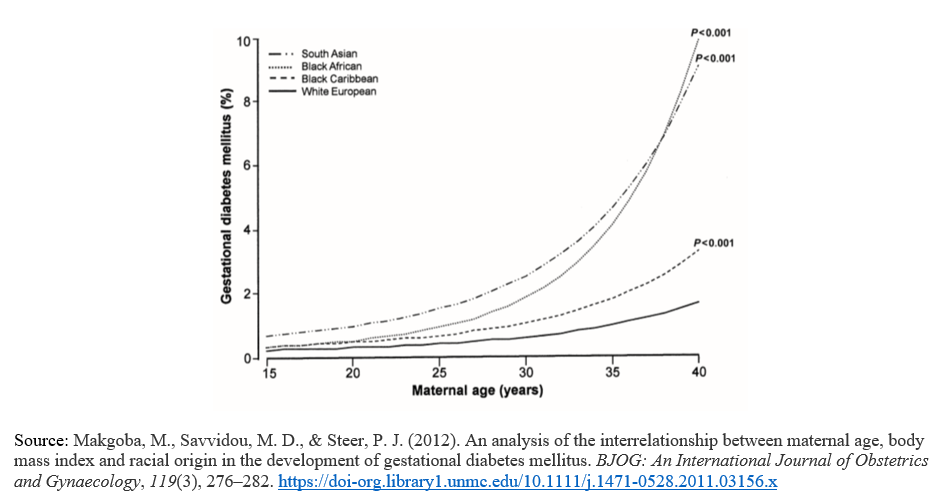Epidemiological Patterns of Gestational Diabetes by Particular person, Place, and Time
Gestational diabetes is a typical well being situation that impacts pregnant girls worldwide. Gestational diabetes is outlined by the American Diabetes Affiliation as a girl with out diabetes creating excessive blood glucose someday throughout being pregnant. In response to an article by Lavery, Friedman, Keyes, Weight, and Ananth (2016), “gestational diabetes is a situation which impacts round eight.three% of pregnancies worldwide.” Gestational diabetes is a rising public well being drawback as girls changing into pregnant are more and more obese or overweight and as maternal age at conception will increase.
As talked about beforehand, gestational diabetes is a rising drawback worldwide. Gestational diabetes is a well being situation which impacts girls of childbearing age (individual). Nonetheless, the consequences of gestational diabetes could also be seen in girls who’re not of childbearing age who had gestational diabetes throughout a being pregnant earlier in life. Gestational diabetes may additionally have an effect on the toddler born to a mom with this situation as gestational diabetes can result in hostile outcomes in prenatal growth. When blood glucose will not be managed in being pregnant the outcomes might embody a child that’s massive for gestational age (LGA), hypertension or ensuing pre-eclampsia, hypoglycemia within the toddler following delivery, and a possible cesarean part for supply which can lead to an extended restoration time following supply (Facilities for Illness Management and Prevention, 2018). In response to Lavery, Friedman, Keyes, Weight, and Ananth (2016), stillbirth has additionally been a threat think about relation to gestational diabetes. Girls with gestational diabetes throughout being pregnant are additionally at higher threat for creating sort II diabetes mellitus sooner or later. Gestational diabetes can also be a public well being drawback in that that is expensive to the well being care system to deal with girls and youngsters with problems from gestational diabetes.
 Gestational diabetes is changing into an rising international burden as nations have gotten extra developed (place). In response to Zhu and Zhang (2016), the prevalence of gestational diabetes has been rising by over 30% within the final 20 years in creating nations worldwide. On this research, information was collected from 36 nations to account for gestational diabetes charges. This research discovered that the Center East, in addition to North Africa, had the very best charges of gestational diabetes with the median fee being 12.9% for these places. The bottom prevalence of gestational diabetes was discovered to be in Europe with a median incidence of gestational diabetes being 5.eight% (Zhu & Zhang, 2016). Gestational diabetes will proceed to be a rising drawback
Gestational diabetes is changing into an rising international burden as nations have gotten extra developed (place). In response to Zhu and Zhang (2016), the prevalence of gestational diabetes has been rising by over 30% within the final 20 years in creating nations worldwide. On this research, information was collected from 36 nations to account for gestational diabetes charges. This research discovered that the Center East, in addition to North Africa, had the very best charges of gestational diabetes with the median fee being 12.9% for these places. The bottom prevalence of gestational diabetes was discovered to be in Europe with a median incidence of gestational diabetes being 5.eight% (Zhu & Zhang, 2016). Gestational diabetes will proceed to be a rising drawback

worldwide as nations develop into more and more sedentary, maternal age will increase, and weight problems continues to be a worldwide well being drawback.
Gestational diabetes will not be often identified till later in being pregnant as it’s usually examined for between 24 to 28 weeks of gestation (time) (Facilities for Illness Management and Prevention, 2018). Gestational diabetes is completely different than sort I diabetes mellitus or sort II diabetes mellitus in that it’s categorised as pregnant girls who didn’t have diabetes previous to conception. Tendencies in gestational diabetes have elevated in the USA over time from 1980 to 2010 as depicted within the determine beneath (Lavery, Friedman, Keyes, Weight, & Ananth, 2016). All pregnant girls must be screened at a while their being pregnant for gestational  diabetes, as there are a number of problems of untreated gestational diabetes. In response to the Nationwide Institute of Diabetes and Digestive and Kidney Illnesses (2017), there are completely different ways in which a practitioner might diagnose gestational diabetes; the glucose problem take a look at, oral glucose tolerance take a look at (OGTT), or each assessments. The glucose problem take a look at consists of a blood draw one hour following the pregnant lady consuming a glucose resolution. If the measurements from this take a look at decide that blood glucose is 140 or increased the lady might have to return again for an OGTT. If the blood glucose is measured at 200 or increased the lady could also be identified with gestational diabetes (Nationwide Institute of Diabetes and Digestive and Kidney Illnesses, 2017). If the lady wants an OGTT, she’s going to first have a blood draw carried out, drink the glucose resolution, then endure subsequent blood attracts each hour for 2 to 3 hours. Excessive blood glucose ranges at any of the blood attracts for this take a look at could be indicative of gestational diabetes (Nationwide Institute of Diabetes and Digestive and Kidney Illnesses, 2017).
diabetes, as there are a number of problems of untreated gestational diabetes. In response to the Nationwide Institute of Diabetes and Digestive and Kidney Illnesses (2017), there are completely different ways in which a practitioner might diagnose gestational diabetes; the glucose problem take a look at, oral glucose tolerance take a look at (OGTT), or each assessments. The glucose problem take a look at consists of a blood draw one hour following the pregnant lady consuming a glucose resolution. If the measurements from this take a look at decide that blood glucose is 140 or increased the lady might have to return again for an OGTT. If the blood glucose is measured at 200 or increased the lady could also be identified with gestational diabetes (Nationwide Institute of Diabetes and Digestive and Kidney Illnesses, 2017). If the lady wants an OGTT, she’s going to first have a blood draw carried out, drink the glucose resolution, then endure subsequent blood attracts each hour for 2 to 3 hours. Excessive blood glucose ranges at any of the blood attracts for this take a look at could be indicative of gestational diabetes (Nationwide Institute of Diabetes and Digestive and Kidney Illnesses, 2017).
As with most situations, there are threat components that predispose girls to have gestational diabetes in being pregnant. In response to a research by Poomalar (2015), some excessive threat teams of girls in danger for creating gestational diabetes embody excessive physique mass index (BMI), having a primary diploma relative with diabetes mellitus, having a earlier toddler born with macrosomia, having a historical past of gestational diabetes in earlier pregnancies, and ladies of sure ethnic descent together with people from Asia, the Caribbean, Arabia, and the Center East. There has additionally been a linkage to maternal age and the event of gestational diabetes throughout being pregnant. In response to Makgoba, Savvidou, & Steer (2012), rising maternal age and BMI are higher threat components for the event of gestational diabetes in South Asian and Black African girls in comparison with White European or Black Caribbean girls (see graph). There has additionally been some dialogue that maternal eating regimen performs an element within the growth of gestational diabetes throughout being pregnant as there are meals decisions which can be apparent in resulting in elevated blood glucose.

There have been many prevention and management measures which were studied with reference to gestational diabetes. The Facilities for Illness Management and Prevention (2018) presents many prevention and management suggestions for girls in danger for or who’ve gestational diabetes. The following pointers embody maintaining a healthy diet meals which can embody getting assist from a registered dietician, exercising commonly to incorporate at the very least 30 minutes of moderate-intensity train at the very least 5 days per week, monitoring blood glucose ranges as directed by a practitioner, taking insulin if prescribed, and getting examined for diabetes mellitus following being pregnant. There’s additionally present research to find out if probiotics and vitamin D assist help within the prevention of gestational diabetes (Poomalar, 2015). Girls who with a previous historical past of gestational diabetes ought to work on future prevention previous to subsequent pregnancies by way of the strategies talked about above.
In conclusion, gestational diabetes is changing into an rising international well being threat. It’s a well being situation which will have an effect on any girls of childbearing age who’s pregnant, plans to develop into pregnant, or has been pregnant. It might additionally affect a creating fetus in addition to an toddler born to a mom who had gestational diabetes throughout that being pregnant. Gestational diabetes happens worldwide, although there’s a increased prevalence in some ethnicities than others (as talked about beforehand). There are various threat components which will predispose girls to develop gestational diabetes and luckily, there are additionally many prevention and management measures to scale back these threat components. Extra work can be wanted in public well being outreach to serving to girls develop into extra conscious of those dangers in addition to the implementation of main prevention measures to lower the incidence of this situation worldwide.
Analysis of Information Sources
Facilities for Illness Management and Prevention: The Facilities for Illness Management and Prevention has ample info obtainable relating to public well being ailments together with gestational diabetes. There’s information obtainable about charges, prevention measures, threat components, and quite a few different info units relating to gestational diabetes on this website. The CDC makes use of the Nationwide Notifiable Illnesses Surveillance System (NNDSS) to achieve info from native and state well being departments. The strengths of utilizing this supply are that that is info obtained from the CDC is dependable and lacks the bias that some analysis research or different web sources might have. I used this information supply as a result of it was useful in that the CDC units main prevention measures which match properly into my rationale for prevention and management measures for gestational diabetes. I additionally benefit from the CDC information as a result of it’s at a stage that people that wouldn’t have public well being or medical background can perceive. That is crucial as a result of the truth that the CDC units many pointers for illness and sickness prevention.
Lavery, Friedman, Keyes, Wright, & Ananth: This can be a analysis article that I obtained by way of EBSCO (UNMC library) which talks concerning the prevalence and dangers of gestational diabetes. This can be a retrospective cohort research from 2016. The strengths of this analysis article had been that it was clear and concise, had no outdoors funding which helped to make sure that bias is proscribed, and this research used a cohort of girls with many alternative variables (various ages, races, marital standing, and so on.). This research was additionally from a peer-reviewed journal (BJOG: An Worldwide Journal of Obstetrics and Gynaecology). Nonetheless, this research didn’t disclose pursuits or limitations. I selected to make use of this analysis article for my venture as a result of it had nice evidence-based suggestions and used epidemiologic patterns and definitions that I may perceive. This text additionally had loads of fascinating info relating to maternal traits associated to gestational diabetes which had been truly exhausting for me to seek out from lots of the different sources. Lastly, I used the determine from this research as a result of it did an ideal job at evaluating completely different races of girls with gestational diabetes, but additionally had a timeline of why the charges of gestational diabetes charges are rising over time.
Makgoba, Savvidou, & Steer: This can be a analysis article that I obtained by way of EBSCO (UNMC library) and is a retrospective research from 2012. This research checked out a number of components in relation to gestational diabetes which incorporates maternal age, physique mass index (BMI), and race of the mom. This research was from the identical peer-reviewed journal because the earlier research I discussed (BJOG: An Worldwide Journal of Obstetrics and Gynaecology). The strengths of this analysis article had been that the info assortment strategies had been very clear, statistical evaluation was achieved in a method that I may clearly comprehend, there was no outdoors funding supply limiting bias, and I appreciated that the outcomes had been depicted in a linear style. I additionally appreciated that this research checked out BMI in with maternal age and race in that top BMI’s correlating to obese and weight problems do have a big function in gestational diabetes growth. A limitation of this information supply was that it was retrospective so information was collected from girls who had been self-reporting these components and this may occasionally result in inconsistency with screening. I selected to make use of this information as a result of I appreciated the info and the way there was a mixed hyperlink between the components of maternal age, BMI, and maternal race. This helped me in realizing that there are a number of components usually performing in conjunction within the growth of ailments together with gestational diabetes.
Nationwide Institute of Diabetes and Digestive and Kidney Illnesses: The Nationwide Institute of Diabetes and Digestive and Kidney Illnesses is a program funded by the Nationwide Institute of Well being (NIH) which conducts medical analysis relating to endocrine and metabolic issues inclusive of gestational diabetes. This information is on the market to the general public and has an intention to extend information and understanding of endocrine and metabolic issues. The strengths of this information are that this info is reviewed by specialists (very like the info from the CDC), the intention is to assist most people so the data is straightforward to learn and perceive, and there’s a wealth of nice info relating to gestational diabetes. A limitation of this supply is that always the info must be written at a stage most people can perceive (normal rule is fifth-grade stage), so there may be not loads of statistical information for this supply. I selected to make use of this supply due to the info relating to testing for gestational diabetes. I’m at the moment pregnant and the data that’s given on this website is similar info that I used to be given in a handout by my midwife.
Poomalar: This can be a journal article written in a 2015 version of the World Journal of Diabetes. This text depicts administration and traits in gestational diabetes. This text begins by talking concerning the traits in gestational diabetes and later talks about prevention and therapy for gestational diabetes. The strengths of this text are that it’s organized properly into sections explaining the prevention, prognosis, and therapy of gestational diabetes, there have been no reported conflicts of curiosity and was peer-reviewed by exterior reviewers. A limitation of this text is that it didn’t embody loads of statistical information or graphical information to elucidate epidemiological traits. I selected to make use of this text as a result of I actually appreciated the way it broke up the completely different details about gestational diabetes, and I like that it very clearly represented the completely different prevention and therapy strategies for gestational diabetes. It additionally depicted some prevention measures which can be at the moment being studied like probiotics and vitamin D supplementation. I additionally felt as if this was a good supply coming from the World Journal of Diabetes in addition to the truth that this text was peer-reviewed.
Zhu & Zhang: This was a scientific evaluate which seemed on the international prevalence of gestational diabetes in addition to the development from gestational diabetes to sort II diabetes mellitus. I info from this text was obtained from accumulating completely different information sources by way of analysis articles from completely different nations. The strengths of this text are that it exhibits charges of gestational diabetes worldwide, depicts that there’s a direct linkage between girls who’ve gestational diabetes and the linkage of creating sort II diabetes mellitus sooner or later, and depicts public well being implications of each gestational diabetes and kind II diabetes mellitus. I additionally appreciated the best way that the world map confirmed the prevalence of gestational diabetes between completely different areas of the world. A limitation of this research was that it was exhausting to comply with at instances and could be troublesome to tell apart the info if the reader didn’t have information relating to healthcare statistics or epidemiology. I selected to make use of this research in my venture due to the data it depicted evaluating the prevalence of gestational diabetes amongst completely different nations and areas, as the vast majority of my different sources solely had info relating to the prevalence of gestational diabetes in the USA.
References
-
Facilities for Illness Management and Prevention. (2018). Gestational diabetes and being pregnant. Retrieved from https://www.cdc.gov/pregnancy/diabetes-gestational.html
-
Lavery, J. A., Friedman, A.M., Keyes, Okay. M., Wright, J. D., & Ananth, C. V. (2016). Gestational diabetes in the USA: Temporal modifications in prevalence charges between 1979 and 2010. An Worldwide Journal of Obstetrics and Gynaecology, 124, 804-813.
-
Makgoba, M., Savvidou, M. D., & Steer, P. J. (2012). An evaluation of the interrelationship between maternal age, physique mass index and racial origin within the growth of gestational diabetes mellitus. BJOG: An Worldwide Journal of Obstetrics and Gynaecology, 119(three), 276–282. https://doi-org.library1.unmc.edu/10.1111/j.1471-0528.2011.03156.x
-
Nationwide Institute of Diabetes and Digestive and Kidney Illnesses. (2017). Checks & prognosis for gestational diabetes. Retrieved from https://www.niddk.nih.gov/health-information/diabetes/overview/what-is-diabetes/gestational/tests-diagnosis
-
Poomalar, G. Okay. (2015). Altering traits in administration of gestational diabetes mellitus. World Journal of Diabetes, 6(2), 284–295. https://doi-org.library1.unmc.edu/10.4239/wjd.v6.i2.284
-
Zhu, Y., & Zhang, C. (2016). Prevalence of gestational diabetes and threat of development to Sort 2 diabetes: A worldwide perspective. Curr Diab Rep, 16(7), 1-11.

 Gestational diabetes is changing into an rising international burden as nations have gotten extra developed (place). In response to Zhu and Zhang (2016), the prevalence of gestational diabetes has been rising by over 30% within the final 20 years in creating nations worldwide. On this research, information was collected from 36 nations to account for gestational diabetes charges. This research discovered that the Center East, in addition to North Africa, had the very best charges of gestational diabetes with the median fee being 12.9% for these places. The bottom prevalence of gestational diabetes was discovered to be in Europe with a median incidence of gestational diabetes being 5.eight% (Zhu & Zhang, 2016). Gestational diabetes will proceed to be a rising drawback
Gestational diabetes is changing into an rising international burden as nations have gotten extra developed (place). In response to Zhu and Zhang (2016), the prevalence of gestational diabetes has been rising by over 30% within the final 20 years in creating nations worldwide. On this research, information was collected from 36 nations to account for gestational diabetes charges. This research discovered that the Center East, in addition to North Africa, had the very best charges of gestational diabetes with the median fee being 12.9% for these places. The bottom prevalence of gestational diabetes was discovered to be in Europe with a median incidence of gestational diabetes being 5.eight% (Zhu & Zhang, 2016). Gestational diabetes will proceed to be a rising drawback
 diabetes, as there are a number of problems of untreated gestational diabetes. In response to the Nationwide Institute of Diabetes and Digestive and Kidney Illnesses (2017), there are completely different ways in which a practitioner might diagnose gestational diabetes; the glucose problem take a look at, oral glucose tolerance take a look at (OGTT), or each assessments. The glucose problem take a look at consists of a blood draw one hour following the pregnant lady consuming a glucose resolution. If the measurements from this take a look at decide that blood glucose is 140 or increased the lady might have to return again for an OGTT. If the blood glucose is measured at 200 or increased the lady could also be identified with gestational diabetes (Nationwide Institute of Diabetes and Digestive and Kidney Illnesses, 2017). If the lady wants an OGTT, she’s going to first have a blood draw carried out, drink the glucose resolution, then endure subsequent blood attracts each hour for 2 to 3 hours. Excessive blood glucose ranges at any of the blood attracts for this take a look at could be indicative of gestational diabetes (Nationwide Institute of Diabetes and Digestive and Kidney Illnesses, 2017).
diabetes, as there are a number of problems of untreated gestational diabetes. In response to the Nationwide Institute of Diabetes and Digestive and Kidney Illnesses (2017), there are completely different ways in which a practitioner might diagnose gestational diabetes; the glucose problem take a look at, oral glucose tolerance take a look at (OGTT), or each assessments. The glucose problem take a look at consists of a blood draw one hour following the pregnant lady consuming a glucose resolution. If the measurements from this take a look at decide that blood glucose is 140 or increased the lady might have to return again for an OGTT. If the blood glucose is measured at 200 or increased the lady could also be identified with gestational diabetes (Nationwide Institute of Diabetes and Digestive and Kidney Illnesses, 2017). If the lady wants an OGTT, she’s going to first have a blood draw carried out, drink the glucose resolution, then endure subsequent blood attracts each hour for 2 to 3 hours. Excessive blood glucose ranges at any of the blood attracts for this take a look at could be indicative of gestational diabetes (Nationwide Institute of Diabetes and Digestive and Kidney Illnesses, 2017).